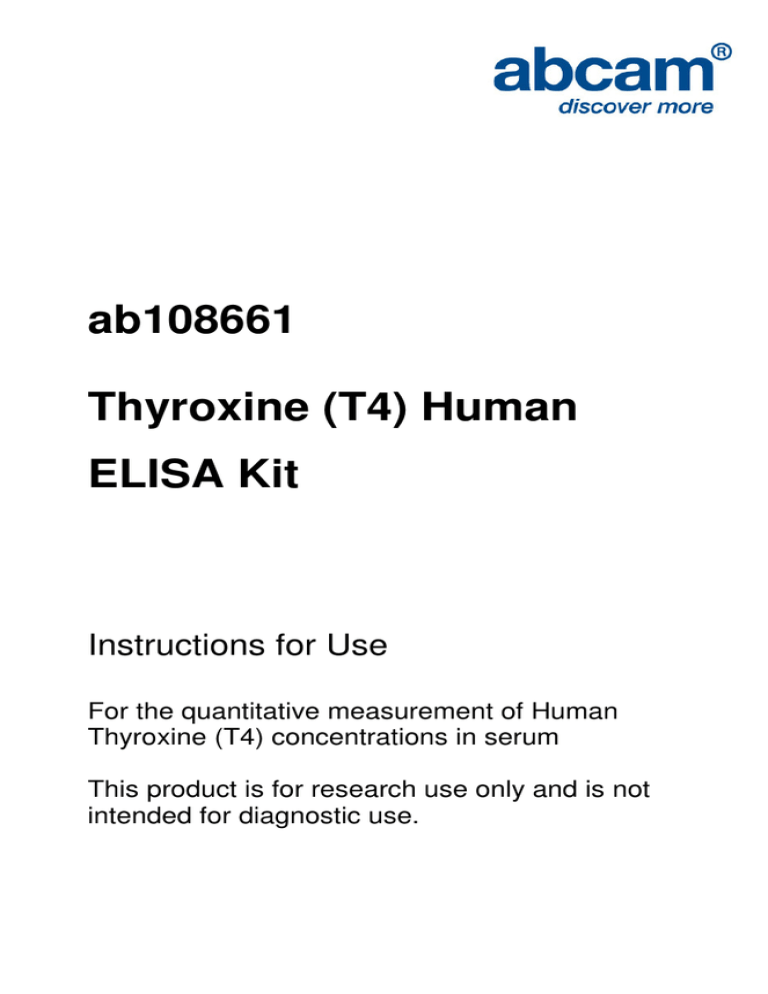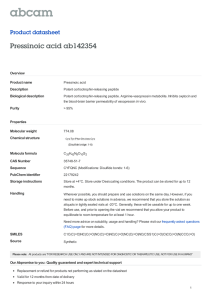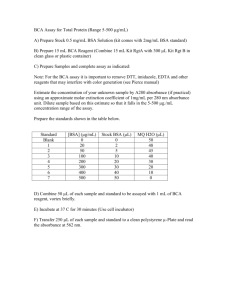
ab108661
Thyroxine (T4) Human
ELISA Kit
Instructions for Use
For the quantitative measurement of Human
Thyroxine (T4) concentrations in serum
This product is for research use only and is not
intended for diagnostic use.
1
Table of Contents
1.
Introduction
3
2.
Assay Summary
4
3.
Kit Contents
5
4.
Storage and Handling
5
5.
Additional Materials Required
6
6.
Preparation of Reagents
6
7.
Preparation and Collection of Specimen
7
8.
Assay Method
7
9.
Data Analysis
8
10. Limitations
11
11. Troubleshooting
12
2
1. Introduction
ab108661, Thyroxine (T4) Human ELISA Kit is intended for the
quantitative determination of Total Thyroxine (T4) concentration in
Human serum.
L-Thyroxine (T4) is a hormone that is synthesized and stored in the
thyroid gland. Proteolytic cleavage of follicular thyroglobulin releases
T4 into the bloodstream. Greater than 99% of Thyroxine (T4) is
reversibly bound to three plasma proteins in blood - thyroxine
binding globulin (TBG) binds 70%, thyroxine binding pre-albumin
(TBPA) binds 20%, and albumin binds 10%. Approximately 0.03% of
T4 is in the free, unbound state in blood at any one time.
3
2. Assay Summary
ab108661 measures Thyroxine (T4) by competitive immunoassay
techniques. A sample of serum or plasma containing the T4 to be
quantified is mixed with labeled T4 and T4 antibody The labeled T4
contains 8-anilino-1-napthalene sulfonic acid (ANS) to inhibit binding
of T4 to serum proteins. A fixed amount of labeled T4 competes with
the unlabeled T4 in the sample for a fixed number of binding sites on
the specific T4 antibody.
Antibody to Thyroxine (T4) is coated on a solid phase (microtiter
well). A measured amount of serum and a constant amount of
Thyroxine (T4) labeled with horseradish peroxidase are added.
During incubation, T4 in the sample and enzyme-labeled T4
compete for the limited binding sites on the T4 antibody.
After a 60 minute incubation at room temperature, the wells are
washed 5 times by water to remove unbound Thyroxine (T4)
conjugate.
A solution of tetramethylbenzidine (TMB) reagent is added and
incubated for 20 minutes, resulting in the development of a blue
color.
The color development is stopped with the addition of Stop Solution.
The intensity of the color formed is proportional to the amount of
enzyme present and is inversely related to the amount of unlabeled
Thyroxine (T4) in the sample. Absorbance is measured
spectrophotometrically at 450 nm.
4
3. Kit Contents
•
Antibody-Coated Wells (1 plate, 96 wells); microtiter wells
coated with Sheep anti-Thyroxine (T4).
•
Reference Standard Set (1 set, 1.0 ml/vial); contains 0, 2, 5, 10,
15, and 25 µg/dl, ready to use.
•
Enzyme Conjugate Concentrate (11x) 1.3 ml Thyroxine (T4)
antigen conjugated to horseradish peroxidase.
•
Enzyme Conjugate Diluent (13 ml) contains 8-anilino-1napthalene sulfonic acid (ANS).
•
TMB Reagent (11 ml).
•
Stop Solution (11 ml).
4. Storage and Handling
Store the unopened kit at 2-8°C upon receipt and when it is not in
use, until the expiration shown on the kit label. Refer to the package
label for the expiration date. Keep microtiter plate in a sealed bag
with desiccant to minimize exposure to damp air. Opened test kits
will remain stable until the expiration date shown, provided it is
stored as described above.
5
5. Additional Materials Required
•
Distilled or deionized water
•
Precision pipettes: 25 µl, 100 µl and 1.0 ml
•
Disposable pipette tips
•
Microtiter well reader capable of reading absorbance at 450 nm.
A microtiter plate reader with a bandwidth of 10 nm or less and
an optical density range of 0-2 OD or greater at 450 nm
wavelength is acceptable for use in absorbance measurement.
•
Vortex mixer, or equivalent
•
Absorbent paper
•
Graph paper
6. Preparation of Reagents
1.
All reagents should be allowed to reach room temperature (1825°C) before use.
2.
To prepare Working Conjugate Reagent, add 0.1 ml of
Enzyme Conjugate Concentrate (11x) to 1.0 ml of Thyroxine
(T4) Conjugate Diluent (1:10 dilution), and mix well.
Note: Prepare only the amount of Conjugate that is
required each time. Working Conjugate Reagent should be
used within 24 hours. Discard the excess after use.
6
7. Preparation and Collection of Specimen
Serum should be prepared from a whole blood specimen
obtained by acceptable medical techniques. This kit is for use
with serum samples without additives only.
8. Assay Method
Assay Procedure:
1. Secure the desired number of coated wells in the holder.
2. Dispense 25 µl of standards, specimens, and controls into
appropriate wells.
3. Dispense 100 µl of Working Conjugate Reagent into each well.
4. Thoroughly mix for 30 seconds. It is very important to mix
completely.
5. Incubate at room temperature (18-25°C) for 60 minutes.
6. Remove the incubation mixture by flicking plate contents into a
waste container.
7. Rinse and flick the microtiter wells 5 times with distilled or
deionized water. (Please do not use tap water.)
8. Strike the wells sharply onto absorbent paper or paper towels to
remove all residual water droplets.
9. Dispense 100 µl of TMB Reagent into each well. Gently mix for
10 seconds.
7
10. Incubate in the dark at room temperature for 20 minutes.
11. Stop the reaction by adding 100 µl of Stop Solution to each well.
12. Gently mix for 30 seconds. It is important to make sure that all
the blue color changes to yellow color completely.
13. Read absorbance at 450nm with a microtiter well reader within
15 minutes.
9. Data Analysis
1. Calculate the mean absorbance value (OD450) for each set of
reference standards, controls and samples.
2. Construct a standard curve by plotting the mean absorbance
obtained for each reference standard against its concentration in
µg/dl on linear graph paper, with absorbance on the vertical (y)
axis and concentration on the horizontal (x) axis.
3. Using the mean absorbance value for each sample, determine
the corresponding concentration of Thyroxine (T4) in µg/dl from
the standard curve.
8
A.
Typical Data
Results of a typical standard run with absorbency readings at 450nm
shown on the Y axis against Thyroid Thyroxine (T4) concentrations
shown on the X axis.
NOTE: This standard curve is for the purpose of illustration only, and
should not be used to calculate unknowns. Each laboratory must
provide its own data and standard curve in each experiment.
Thyroxine (T4)
(µg/dl)
Absorbance (450 nm)
0
2.667
2
1,786
5
1.060
10
0.778
15
0.591
25
0.384
9
B.
Sensitivity
The minimum detectable concentration of Thyroxine (T4) by this
assay is estimated to be 0.4 µg/dl.
10
10.
•
Limitations
Reliable and reproducible results will be obtained when the
assay procedure is carried out with a complete understanding of
the package insert instructions and with adherence to good
laboratory practice.
•
Serum samples demonstrating gross lipemia, gross hemolysis,
or turbidity should not be used with this test.
•
The wash procedure is critical. Insufficient washing will result in
poor precision and falsely elevated absorbance readings.
•
The results obtained from the use of this kit should be used only
as an adjunct to other diagnostic procedures and information
available to the physician.
11
11.
Troubleshooting
Problem
Cause
Solution
Poor standard
curve
Improper standard dilution
Confirm dilutions made
correctly
Standard improperly
reconstituted (if
applicable)
Briefly spin vial before
opening; thoroughly
resuspend powder (if
applicable)
Standard degraded
Store sample as
recommended
Curve doesn't fit scale
Try plotting using different
scale
Incubation time too short
Try overnight incubation at
4 °C
Target present below
detection limits of assay
Decrease dilution factor;
concentrate samples
Precipitate can form in
wells upon substrate
addition when
concentration of target is
too high
Increase dilution factor of
sample
Using incompatible
sample type (e.g. serum
vs. cell extract)
Detection may be reduced
or absent in untested
sample types
Sample prepared
incorrectly
Ensure proper sample
preparation/dilution
Wells are insufficiently
washed
Wash wells as per
protocol recommendations
Contaminated wash buffer
Make fresh wash buffer
Waiting too long to read
plate after adding STOP
solution
Read plate immediately
after adding STOP
solution
Low signal
High
background
12
Large CV
Low sensitivity
Bubbles in wells
Ensure no bubbles
present prior to reading
plate
All wells not washed
equally/thoroughly
Check that all ports of
plate washer are
unobstructed/wash wells
as recommended
Incomplete reagent mixing
Ensure all
reagents/master mixes
are mixed thoroughly
Inconsistent pipetting
Use calibrated pipettes
and ensure accurate
pipetting
Inconsistent sample
preparation or storage
Ensure consistent sample
preparation and optimal
sample storage conditions
(e.g. minimize
freeze/thaws cycles)
Improper storage of
ELISA kit
Store all reagents as
recommended. Please
note all reagents may not
have identical storage
requirements.
Using incompatible
sample type (e.g. Serum
vs. cell extract)
Detection may be reduced
or absent in untested
sample types
For further technical questions please do not hesitate to
contact us by email (technical@abcam.com) or phone (select
“contact us” on www.abcam.com for the phone number for
your region).
13
14
UK, EU and ROW
Email: technical@abcam.com
Tel: +44 (0)1223 696000
www.abcam.com
US, Canada and Latin America
Email: us.technical@abcam.com
Tel: 888-77-ABCAM (22226)
www.abcam.com
China and Asia Pacific
Email: hk.technical@abcam.com
Tel: 108008523689 (中國聯通)
www.abcam.cn
Japan
Email: technical@abcam.co.jp
Tel: +81-(0)3-6231-0940
www.abcam.co.jp
Copyright © 2012 Abcam, All Rights Reserved. The Abcam logo is a registered trademark.
15
All information / detail is correct at time of going to print.






